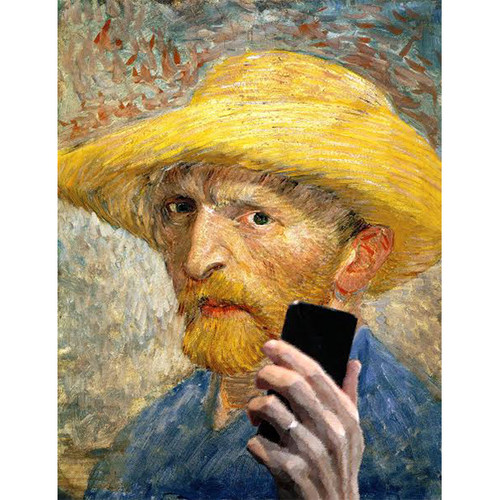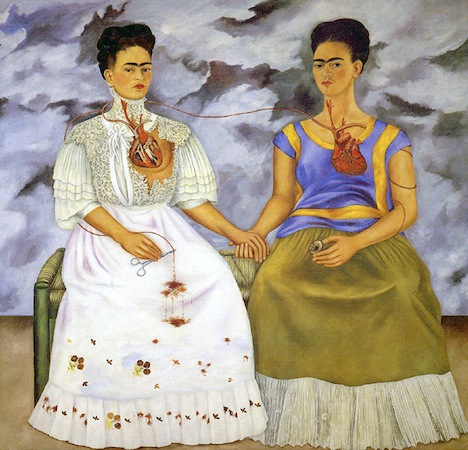Using a camera phone to take a picture of yourself, or taking a “selfie”, has become increasing popular with the advent of new front facing cameras on iPhones and other modern cell phones. This innovation has made capturing selfies easier than ever, as you can watch a real-time photographed reflection of yourself in order to find your most flattering angles.
Since the publishing of Kim Kardashian’s book composed entirely of selfies, cleverly entitled “Selfish”, people have begun to pay more attention to the “selfie” as a form of expression. Companies have developed “selfie sticks”, adjustable monopods used to position camera phones beyond the normal range of an arm. The photo and video sharing application “Snapchat” has even turned this phenomenon into a multi-billion dollar industry. According to Google, more than 93 million selfies are taken every day… But is it art?
(photo: Michael Schoch / museumofselfies.tumblr.com)
The desire to represent oneself through art is not new to this century. Since antiquity, artists have used themselves as subjects. One of the very first self-portraits was made by the Pharaoh Akhenaten’s chief sculptor Bak in 1365 BC. Since then, countless self-portraits have been made of artists at work, at leisure, or in formal settings.
Using oneself as a subject is easy and practical. Instead of finding and hiring a model, why not pick up a mirror and use your own image? Frida Kahlo, the surrealist artist celebrated for her tragic self-portraiture famously said, “I paint myself because I am so often alone and because I am the subject I know best.”
One of my all-time favorite self-portraits: Frida Kahlo’s The Two Fridas, from 1939 (photo: Kahn Academy)
Let’s take Cindy Sherman, for example. The American artist and MacArthur fellow is best known for her series of photographs that document herself in a range of costumes. She produces her photos completely independently, assuming the roles of director, model, make-up artist, wardrobe stylist, and hair-dresser. In this sense, it is not difficult to draw connections between the photography of Cindy Sherman and the stereotypical selfies of so many young women today. In taking a selfie, you assume control of the way that you chose to represent yourself to the world.
However, it would be naïve to pass off Cindy Sherman’s famous work simply as selfies. Cindy Sherman’s deliberate photography requires a great deal of thought in order to address larger questions such as the nature of representation and the female’s role in history and contemporary society. It is the opinion of many art critics that a work can be considered a piece of art if the artist’s intent was to create a work of art. From this point of view, if the person taking the selfie considers it to be a work of art, why shouldn’t we?
One of Cindy Sherman’s “selfies” (photo: resourcemagonline.com) See more of her work here.
Many people feel that selfies are a reflection of the vanity of today’s younger generation. As Youtube and television character Kid President so aptly put it, “Fewer selfies. More other peoplies.” Interestingly enough, research has shown that posting too many selfies to social media sites like facebook can have a negative effect on your real-world relationships. A recent Ohio State University study even saw strong correlations between selfies and anti-social traits like narcissism and psychopathy. In an op-ed for Pacific Standard, freelance writer Kyle Chayka wrote, “Selfies are no more art that a can of paint falling on a blank piece of paper is a Jackson Pollock.”
On the other hand, selfie supporters argue that sharing photos of yourself is an important means of self-expression and self-exploration that can be used to express feelings and share important experiences. I believe that it all boils down to the human desire to capture a memory through art. In this way, it is possible to argue that a selfie can be considered an art form.
This discussion leads us to the age-old question: what is art? Numerous theses, seminars, and workshops have grappled with this subject, and I could never do it justice in the parameters of this blog post. Instead, I will leave you with some wisdom from Greek philosopher Aristophanes, who wrote this in the fourth century B.C.: “Let each man exercise the art he knows.” More recently, Andy Warhol said, “Art is what you can get away with.”
So, find your best lighting and snap some selfies (if that’s the art that you know). What do you think, can selfies be viewed as art? Urban Gateways teaching artists often engage their students in self-portraiture as an exercise. Should selfie photography be included in that? Comment below, we would love to hear your thoughts!

A selfie of some of our Urban Gateways staff members!
For further reading on selfies, self-portaiture, and selfies as art, check out these articles:
Before the Selfie: The Self-Portrait What’s the Difference between a Selfie and a Self-Portrait 20 Art Masterpieces Turned into Selfies



